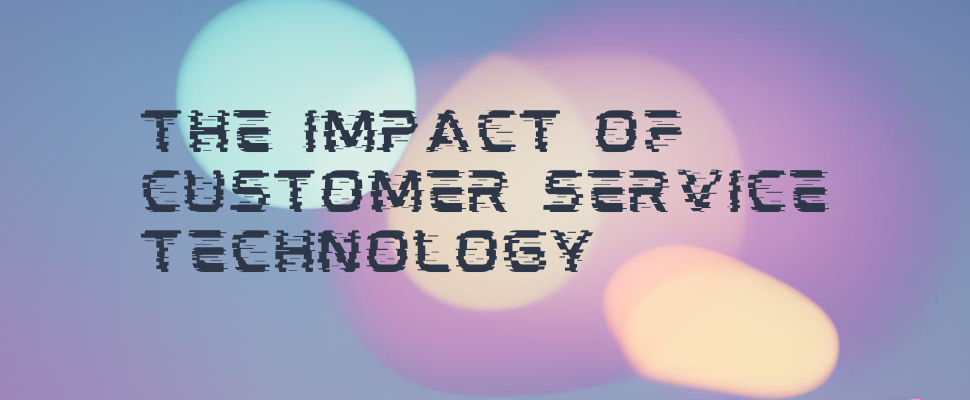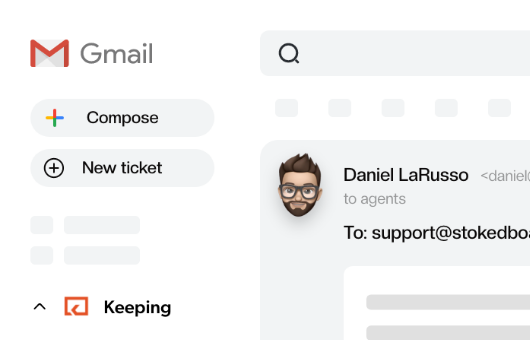
The Impact of Customer Service Technology
The customer service landscape is constantly changing, and many of these changes are driven by the development of new technologies. More is becoming possible regarding how we help customers, and improvements are coming to the experience that businesses can provide.
Humans are the core part of customer service that can never be replaced, yet humans who are assisted by customer service technology are empowered to provide superior support to their customers.
In an excellent piece called Being Human is Good Business, Kristin Smaby talks about how important it is to emphasize the human element of customer service. While essential to read in its entirety, she talks about the importance of focusing on ‘human-centric’ customer service as opposed to the current model of ‘issue-centric’ customer service.
However, human-centric customer service interactions still rely on technology to underpin their efforts. Instead of solving a problem and moving on, Smaby argues that customer service agents should be empowered to look at the whole context of the customer relationship, which is no doubt provided by CRM systems and other tools.
As customers are increasingly moving online, this shift has been supported by adopting new customer service technologies that improve the digital experience. Agents have access to a wealth of customer data that can show them customer preferences, purchasing history, and even predict future behavior.
Benefits of customer service technologies
Customer service technology can fundamentally transform how businesses are serving their customers, dramatically improving the quality of service they can provide as well as the speed at which they are helping customers. If businesses are not making use of the latest customer service technology, they risk falling behind their competitors who are able to offer a superior customer experience.
Customer expectations are rising, and they also expect businesses to be using the most up-to-date technologies. Customer-first companies like Amazon and Tesla are setting the bar high for the customer service industry and customers are increasingly looking for the same level of service from their other providers. More than 65% of people have higher expectations of customer service than they did three to five years ago.
The agent experience is enhanced when they are using better customer service technology, some allowing agents to work from home or to have improved access to customer data. When agent satisfaction rises, this leads to a better experience for customers through agents who are willing and able to go the extra mile. According to research, happy agents are three times as likely to feel empowered to resolve customer issues.
When businesses invest in customer service technology, this shows they care about the customer service delivery within their organization. They don’t expect customer service reps to struggle with antiquated systems that aren’t quite up to the task. They are easily able to handle any customer issue that enters the business and impress the customer with the quality of their response.
Read More: The Future of Customer Service
Top customer service technologies
Now, we’ll talk about the top customer service technology trends you should be aware of.
Self-service automation will grow
Customer service agents are notoriously under pressure to help rising numbers of customers. Self-service technologies can ease the burden on agents by relieving them of the need to react to large numbers of repetitive queries. When businesses provide tools like knowledge bases, FAQs, and tutorials, customers are empowered to help themselves through customer service automation.
In fact, 67% of customers prefer self-service over speaking to a support agent. If they have a simple issue, they don’t want to jump through the hoops of getting in touch with your customer service department, especially if the issue can be resolved quickly online. Self-service automation saves your customers time because they don’t have to wait around for a response, delivering a better overall customer experience.
It’s a technology that empowers customer service agents to do their best work because mundane queries are taken care of. Knowledge base tools, community forums, automated prompts, and FAQs are all examples of self-service automation tools that give your customers an independent means of solving their problems.
Companies make the move to mobile
Customers are increasingly moving to mobile devices which they use to interact with your company’s customer service department. Company websites, support portals and other customer-facing tools need to be optimized for mobile. It’s the worst customer service experience when the site you’re using crashes because it wasn’t designed well for use on mobile.
59% of all internet traffic worldwide now comes from mobile, and 84% of customer-centric companies are now focusing on the mobile customer experience. Customer support teams can’t operate effectively unless they are meeting customers on this platform.
Customers interacting with your help desk must increasingly be able to do so through their mobile. Think of all the customers contacting your brand on social media which is most likely to take place through a smartphone.
You must offer clear contact customer service buttons on your mobile website or app. It’s likely that customers will be contacting you on the go and will expect a streamlined customer experience. Today’s customers are in a hurry and customer support systems must be responsive to mobile.
Omnichannel experience becomes essential
The modern digital customer is contacting businesses on a variety of channels when they need help, and they expect the same customer experience across every single one. Omnichannel support means customers can move across channels and have an integrated experience, avoiding the need to repeat information or losing contact with their chosen customer service rep.
Businesses that adopt omnichannel strategies benefit from 91% higher year-over-year customer retention rates compared to businesses that don’t. As well as improving the standard of customer service businesses are able to offer, it also drives revenue.
Customers are more satisfied when they are not restricted by the channel they contact you from. Customers don’t “see” channels, but are merely looking for assistance from your support reps. They expect businesses to be able to handle enquiries no matter where they are submitted. Omnichannel solutions like help desks make it easy for your support reps to view customer enquiries under one roof.
Co-browsing and video chat become the norm
One of the biggest drawbacks of online customer service has always been the lack of face-to-face interactions. It’s harder to tell how the customer is feeling and respond empathetically when you lack normal cues like facial expressions.
This is why video chat (along with co-browsing) is becoming more prevalent as customer service software. Customers are able to reach out to your reps and connect with them using video chat which more closely mimics a face-to-face experience. Customer issues are able to be resolved far more efficiently when reps and customers can establish a rapport through video.
31% of users report that it is easier to connect with customers through the use of video collaboration. Co-browsing also makes it easier to help customers in real-time as you have access to their screen, reducing the need for long explanations to diagnose the problem. Being able to work more closely with customers dramatically improves resolution rates.
AI chatbots help more customers
AI chatbots are conversational interfaces that help customers solve simple problems with the product or service. As relatively new customer service technology, bots are able to learn from their interactions with customers to provide more intelligent answers using artificial intelligence, reducing the need for customers to contact a human support agent. While most customers still prefer the human touch, familiarity and openness to bots is on the rise.
Chatbots are useful for their capability to support human agents to help more customers without requiring additional resources. 23% of customer service companies are presently using AI chatbots, while 80% of customers have interacted with a chatbot at some point. Using chatbot technology to augment customer service results in a more scalable customer service team.
Chatbots make it a real possibility for more businesses to provide round-the-clock support, and multilingual bots enable businesses to cater to more languages. Potential for increased revenue is the result of your business’s significantly expanded customer base.
Help through social media
Customers are increasingly taking to social media to voice their concerns, especially if their issue is urgent or they desperately want to get the attention of the brand in question. From 2021 to 2022, the number of customers who preferred to use social messaging for customer service increased by 110%.
If your business is not present with customer service on all the most popular platforms like Facebook, Instagram and Twitter, then you need to think about expanding your social media strategy. This customer service technology trend relates to our earlier trend of omnichannel support as well as making the move to mobile.
Neglecting your customer service mentions on social media results in very bad PR for your company. Your most vocal customers are the ones that have the biggest potential to damage your reputation, since they will make their complaints in a public forum. Offering timely resolutions is critical to maintaining mastery of this important support channel.
An increase in data-driven customer service
One of the biggest advantages of customer service technology is you suddenly have access to a wealth of data about your customers. You have insight into how your customer service teams are performing through tools like help desks, or information about your customers through CRM tools. Ticket management software helps you understand which issues are most prevalent and empowers your business to take steps to correct it.
Workforce management tools make it easier to schedule in your customer service teams because you can see when you need to make more agents available. Chatbots can collect all sorts of data about your customers and considerably speed up the process of issue resolution.
Customer service technology means businesses have a much clearer picture of who their customers are and what their needs are likely to be. This proliferation of data enables much more personalization in the way businesses interact with their customers, allowing businesses to maintain the human touch on a much larger scale.
Interest in customer feedback tools
Businesses are taking customer feedback tools much more seriously as the impact of communicating directly with customers cannot be ignored. Communication with customers needs to be a two-way street, since unhappy customers are likely to take their complaints to social media anyway.
Customer survey software enables businesses to quickly and effectively survey their customers using metrics like the Net Promoter Score, or Customer Satisfaction Score, to regularly keep track of what customers really think about your business. 62% of surveys are being opened on a mobile device, which tallies with our earlier mention of customers moving to mobile.
Customer feedback tools means your customer service staff can be more closely connected to customers and find out how they are performing. Directly asking customers for their thoughts enables significant improvements to be implemented, which would never be considered without gathering feedback.
Wrapping up
The customer service landscape is always changing, and many of these changes are driven by the development of new technologies. More is becoming possible with regards to the way that we help customers, and improvements are coming to the experience that businesses can provide. Especially with the spread of social media, customers are becoming more empowered than ever and they expect far more from your business.
Technology enables customer service teams to scale more sustainably and do more with fewer resources. Self-service automation and chatbot tools are essential for teams that are trying to grow with a limited number of agents. It’s all about freeing up your agents to focus on the more complex cases, and giving them more time to spend with each customer.
One aspect of customer service technology that cannot be ignored is our enhanced access to customer data. We not only understand more about customers themselves, but also gain insight into agent performance and level of service that is being provided. Data makes customer service more accurate and targeted, enabling businesses to accurately assess their performance.
Join 150+ teams that are sharing inboxes with us
The easiest way to upgrade your shared Gmail account. There’s no credit card is required.






